Walking through Shipibo Villages
7 October, 2007, 10:21 am in "Peru"
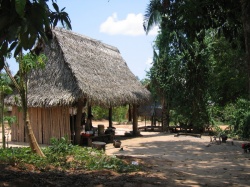 This morning we walked through Santa Clara, Santa Lucia and San Francisco. Our boat dropped us off and we walked to the community of Santa Clara. The houses are more traditional than in San Francisco: thatched roofs, thatched half walls and dirt floors and built high enough on hills so they wouldn't flood. At one house they were in the process of preparing new thatch. There were rows of sticks with the palm leaves carefully cut and bent in orderly rows. The leaves were green so they had to dry in the sun. A thatch would last about 10 years.
This morning we walked through Santa Clara, Santa Lucia and San Francisco. Our boat dropped us off and we walked to the community of Santa Clara. The houses are more traditional than in San Francisco: thatched roofs, thatched half walls and dirt floors and built high enough on hills so they wouldn't flood. At one house they were in the process of preparing new thatch. There were rows of sticks with the palm leaves carefully cut and bent in orderly rows. The leaves were green so they had to dry in the sun. A thatch would last about 10 years. Lalo showed us the pinon tree whose sap was good for curing ear infections as well as the dragon's blood tree, another useful tree whose sap is deep red and can cure ulcers, internal and external injuries. There is a factory in town which dries it and exports it to the US for use in pills.
At another house 2 women were making wind chimes using the thick heavy scales of a local fish and beads. We stopped and chatted for a while and tried an interesting fruit called a guava but nothing like the Hawaiian guavas my mother makes into jam. This guava was a long pod with furry seeds inside. The fruit was the furry skin which you peel off the seed and chew.
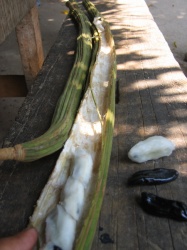
The next stop was a simple house with a fire pit in the yard. The house was a raised wood floor with a hammock, thatched roof, and partially thatched sides. A woman was busy painting bird and turtle shaped red banks with black Shipibo patterns. She showed us how she made the hollow figures by scraping a ball of clay into a hollow half sphere. There was a bucket of ash from a specific tree (Apacharama) which could be mixed with the clay. When we asked her about the Shipibo patterns she said she just learned them by watching people paint them. Since we couldn't buy anything, we paid her some sols for the demonstration. She tried to give us a bunch of necklaces and we had to explain we couldn't carry stuff and the money was for the lesson.
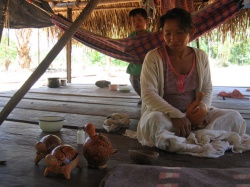
As we reached San Francisco, we were met by the smell of roasting chicken. Everyone was busy preparing food for the celebration. Everywhere there were fires with chicken roasting or big pots of rice covered with banana leaves. We saw Luis and said , "hi".
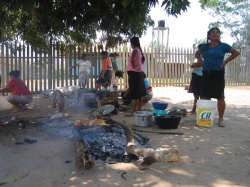
Our last stop was a house that had a lot of ceramic pieces. Rowshan got the ratio of ash to clay used and saw some of the pigments they used. They also explained how they made the pots shiny with the sap of a lacre tree. While the pots were still warm, they'd rub the block of hard sap over them which would melt, leaving a thin layer of lacquer.
We also got an interesting answer about the meaning of the lines in the Shipibo designs. The main potter said his grandfather had said the white represented mountains. When the Incas came to the rain forests they asked the Shipibo to teach them about pottery. Eventually, the black lines came to represent the rivers and Incan roads.
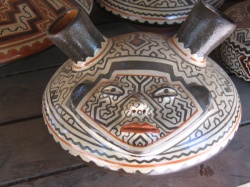
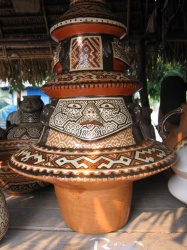
In the afternoon, our final activity of our stay at the lodge was a dreaded visit to a zoo. I'd been hoping to avoid the zoo fearing a depressing series of tiny cages with bedraggled animals.
It turned out it was actually an animal breeding facility. Most of the animals were reptiles and although it is of course better for them to be in the wild, they didn't seem too bothered by being in captivity (they were breeding). Instead of rows of cages, the zoo was a large grassy area with a few big trees enclosed by a tall fence. There were some birds wandering around including a silly black bird that had a very funny call. In the big tree there were squirrel monkeys, parrots and a hawk. There were a couple pools of caymans and several enclosures with various anacondas. The tiny frogs had a huge enclosure.
However, the friendliest animals were the pair of tapirs who loved licking salt of people's skin.
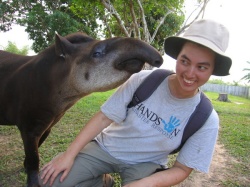
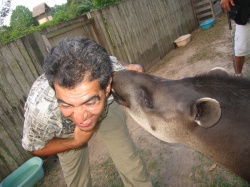
Back in Pucallpa, it was a busy Saturday night. The air was heavy with humidity and heat. After a cold shower, we went to the Plaza de Armas. It was packed and we heard drum and flute music. As we approached we saw groups of young people dressed in traditional Shipibo clothing. It was a competition and I was amazed by the energy the groups managed to muster up in the sweltering night. All of the dances were accompanied by live music. As one group finished, the main female dancer was escorted to the podium where she made a little speech and then introduced the next
group. It turned out to be the Senorita Pucallpa
beauty pageant. Each contestant was introduced through a traditional dance number backed up by a group from her village.
At the edge of the plaza, we got some pizza. While
sitting at the restaurant, 3 musicians (a guitarist, a drummer in a punk rock t-shirt, and a charango/ panpipes player). They played the beautiful traditional Andean music I had fallen in love with when I first bought a cassette of Peruvian music, years and years ago. We'd been in Peru over a month and this was the first time we heard a group play this traditional music, acoustically. Now everywhere you hear panpipes playing effect laden renditions of pop songs. The electronic keyboard has done its share of chewing up traditional music, too. This group played and sang a few songs. Their voices blended in harmonies that make me think of mountains.
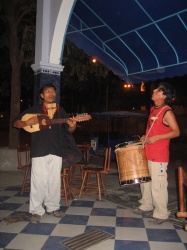
The next morning we woke to the crack of thunder and a down pour. This type of rain was a relief. It was as if the air, thick with heat and humidity finally cracked and all the irritation is released in cool rain.
Comments
- Comments
Powered by My Blog 1.69. Copyright 2003-2006 FuzzyMonkey.net.
Created by the scripting wizards at FuzzyMonkey.net..
(Code modified by Rowshan Dowlatabadi)
Created by the scripting wizards at FuzzyMonkey.net..
(Code modified by Rowshan Dowlatabadi)

